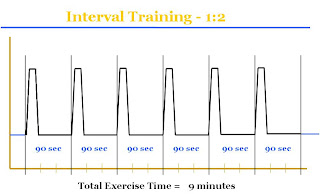Here is another recent question by one of our readers:
Can you tell me if there's any truth to the following two beliefs regarding working out:1. You have to change your strength training workout regularly or your muscles become 'lazy' and used to the workout.
2. A steady cardio workout (i.e. 30 minutes steady jogging on the treadmill) isn't effective. In order to be effective you need to do high intensity interval training.
These are terrific questions and are commonly discussed in the fitness community...
Let's look at these questions individually. The first question addresses the issue of how often you have to change your training (if at all).
First, doing exercise is always going to give you some benefit. However, if you do the same exercises over and over, your muscles will adapt to the exercises, giving you less of a benefit over time. This is a natural process of adaptation - in essence, your body becomes more efficient at doing what you ask of it. To counteract this, all you need to do is vary your fitness. The complication becomes how often you need to vary your routine and how to do so.
One way of varying your routine is simply through cross-training. If you do different types of exercise on different days (e.g. weight-lifting one day, running the next), you will have broader fitness benefits and may minimize the risk of injury. Within an activity, you should also regularly vary your exercises. For weightlifting, you can do this by altering the actual exercises, the workout format, the amount of weight lifted, the number of sets and reps you perform, the way you grip the weights and/or perform the movements, or by doing different exercises altogether (e.g. squat vs. lunge).
There is no one perfect answer for how much you should vary your routine. Everyone is different, with different bodies and physical capacity, different speeds of adaptation to exercise, and different goals. We recommend that you adopt new exercises when it feels right (i.e. you feel ready) and you want to incorporate more variety. It's also a good time to change it up when you're dealing with injury or stress (to minimize the strain on your body). By changing it up every so often, you keep exercise interesting and fun, which in the long run will advance your fitness by keeping you working out consistently over your lifetime. Some may want or need to change their routines more frequently, while others will be fine maintaining their routine for longer periods of time.
The second question deals with the effectiveness of steady-state cardio versus interval training. As with the first question, there is a benefit to exercising regardless of what you're doing. The other important aspect to consider is your fitness goals and physical capacity.
We have personally experienced great benefits from interval training. That's not to say that we don't go for longer, slow runs or swim a number of laps at a moderate pace on occasion. We do these types of activities when we have time and want a change. If we're looking for a fitness challenge and are focused on results (i.e. becoming faster and leaner, in the most efficient way), then we turn to intervals.
You can easily incorporate interval training into any cardio routine - you can even incorporate it into your weightlifting. To understand the concept of interval training, see the figure below which shows a quick burst of activity for about 30 seconds, followed by 60 seconds of lower intensity. The time periods are variable, but that's essentially it - alternating high and low intensity activity. You can also interval train based on distance instead of time (e.g. while running or swimming, do a certain distance all out at maximum intensity and then slow your pace to allow for recovery).
Interval training accomplishes a lot in a little amount of time. Rather than quoting statistics or studies, it's easiest to demonstrate the effect in real life. Try doing a tabata set. You can even pick a simple exercise like bodyweight squats. Do 20 seconds of full intensity (moving non-stop at your maximal pace while maintaining good form). Then take a 10 second rest. Repeat this for 8 circuits, which is 4 minutes in total. That's a much different feel from a steady 4 minute jog, right?
Again, you should select your type of activity based on your physical capacity and fitness goals. Ideally, you'll use both steady state and interval training as tools in your fitness arsenal. They are both great methods to help you keep fit and active!
- Tannys & Alex





No comments:
Post a Comment